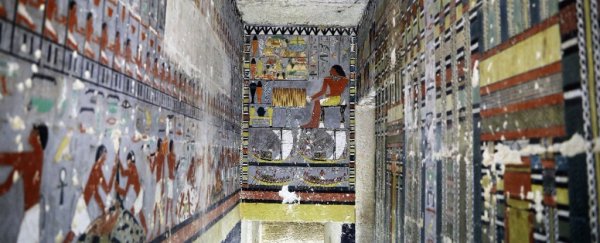Two incredible tombs in Egypt have been discovered in such an exceptional state of preservation that even the murals on the walls have retained their dazzling hues.
One of the tombs is in the Akhmim necropolis in the province of Sohag - discovered because a gang of tomb robbers carrying out an illegal excavation was arrested nearby, according to the Egyptian Ministry of Antiquities.
The tomb dates back over 2,000 years, to the Ptolemaic era, and belonged to a senior official named Tutu and his wife. In the tomb's two rooms, archaeologists found elaborately painted walls, two limestone sarcophagi, and an exceptionally well-preserved mummy.
But, in addition to the human remains, over 50 mummified animals were found. These included ibis, falcons, eagles, dogs, cats and rodents - shrews, according to Egypt Today, which represented the blind aspect of a Sun god.
"It's one of the most exciting discoveries ever in the area," said Mostafa Waziri of the Supreme Council of Antiquities.
The other tomb, from Saqqara, is significantly older, dating back over 4,000 years to the time of Pharaoh Djedkare Isesi.
It belonged to a high-ranking official named Khuwy, and its highly unusual, with a tunnelled entrance usually reserved for pyramids, and colours usually reserved for royalty in its vivid murals.
This has led archaeologists to think that Khuwy may have been related to Djedkare Isesi in some way. So the tomb may shed light on the mysterious Pharaoh's 40-year reign.
According to a CNN report, the tomb is L-shaped, with a small corridor, an antechamber, and a large main chamber, with murals that depict Khuwy seated at a table of offerings.
Archaeologists also found Khuwy's mummy, as well as the canopic jars in which organs are placed for burial. Sadly, these were broken into pieces.
Egypt has been working hard on publicising its archaeological efforts in recent months, in an attempt to boost the country's low tourism numbers. At the end of last year, the Ministry unveiled two spectacular tombs, one dating back 3,500 years, and another 4,400 years old, belonging to a priest named Wahtye.
Yet another 2,500-year-old tomb was found to contain dozens of mummified cats and scarab beetles.
At a presentation unveiling the tomb of Tutu, Waziri said he hoped the discovery would "draw the world's attention to the civilisation and antiquities of Egypt."
